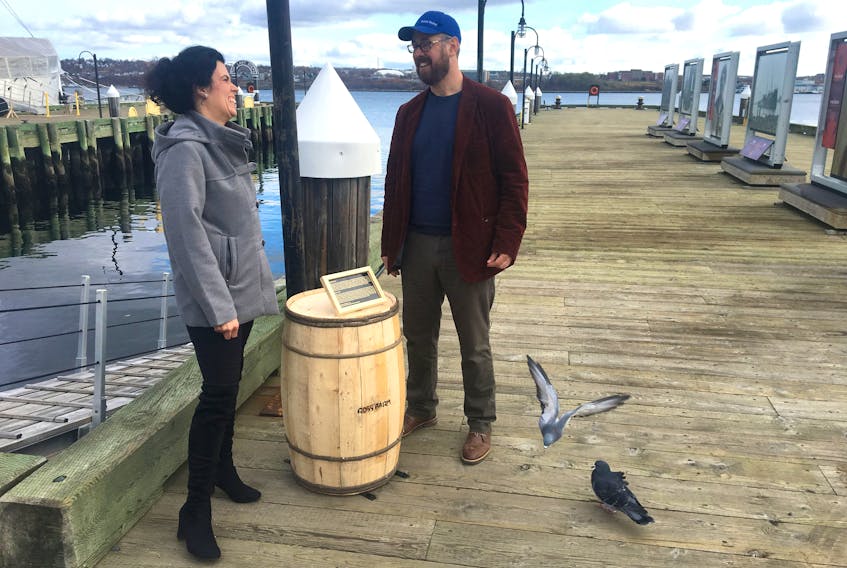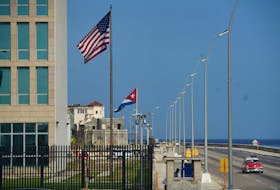They seemed happy to see me when I arrived at the South Jetty behind the Museum of the Atlantic Tuesday.
OK, the trio of museum folk seemed delighted that any living, breathing person had shown up at the unveiling of a celebratory barrel — newly cut, 40 centimetres wide and 137 centimetres tall, with Ross Farm stamped on the body — to commemorate the trading links between rural Nova Scotia and the Port of Halifax.
Some stories just don’t lend themselves to easily digestible sound bites.
Which is how I found myself, a few minutes later, in a coffee shop farther down Lower Water Street. There Peter Cullen, the director of the Ross Farm Museum, started to tell me the story of the “iconic” barrel that is “so rustic that it is almost majestic,” as well as being the perfect vessel to explain something fundamental about this province and its history.
First he had to take me back in time.
To the 1830s and '40s, when the Halifax wharves stank of fish, old wood and whale oil and entrepreneurial folk like Edward Ross, the ambitious son of the founder of the settlement of Sherbrooke (eventually New Ross), arrived by ship at the nearby docks.
Ross came in search of china cups, nails, rum, hats, clothing and other mercantile goods to take back to his dry goods store from which they circulated through “the uplands colonies” of pre-Confederation Nova Scotia.
“In return he would supply the ports of Chester, Chester Basin and Halifax with fish barrels,” said Cullen.
In Halifax “the Keith Richards of the Ross family,” sounds like he had a high old time, talking his way into the rum cabins of visiting frigates and making connections with the settlement’s ascendant business elite, names like Stairs, Collins, Fairbanks, Allison and Black, who controlled the wharves upon which, as of Tuesday, the Ross Farm-made barrel now stands.
Cullen told me that Ross left a brother to run the farm and decamped to Boston where things didn’t go so well for him. In time he returned to Nova Scotia, before ending his days in Port Maitland, Yarmouth Co.
By then, Nova Scotia was part of Canada and the schooner fishery was seeing increased competition, leading to a decline in demand for fish barrels. The apple barrel industry, however, was taking off.
Apple barrels — which could be used once and then burned or broken up — were cheaper and easier to make than fish barrels, which were expected to handle multiple shipments.
Cullen says that those barrels were the shipping crate of their day, since a single man could roll two of them, containing 150 apples each, down a gangplank at the same time.
Forest-bound New Ross was at the centre of this burgeoning trade, which soared following the First World War, when the new rail lines and other increased infrastructure, connected Nova Scotia to the British Dominion, particularly London, the largest market for Nova Scotia apples.
In 1929, the peak of the apple trade in this province, seven million barrels of apples, each containing 150 apples, were shipped by rail from the Annapolis Valley through Halifax, then on to England. As Cullen points out, that works out to about one billion apples from this single province.
About one million of those barrels — the staves out of ash, maple and other hardwoods, with the hoops fashioned from softwood saplings -- were made in New Ross, home to 152 coopers, where the newly mechanized barrel stave mills operated night and day.
Nothing lasts forever, of course. Tuesday, not far from where those barrels of fruit arrived for shipment overseas, Cullen explained how, during the Second World War, the British discovered that it was cheaper to grow their own apples than to import them across the Atlantic.
Nowadays some old-time artisans still make wooden barrels at the Ross Farm Museum, but that is pretty much it in the uplands area, where Christmas trees, not apples, are the main product that the rest of the world wants.
“We talk a lot about shipbuilding and offshore as economic drivers,” Cullen said. “But for a while it was apples.”
And a simple barrel just like the one now standing on a Halifax wharf helped connect this place to the bigger world.









